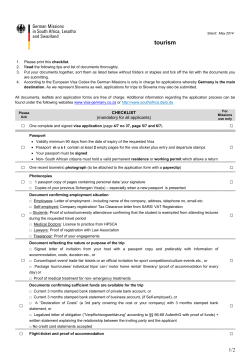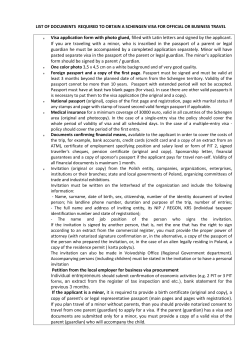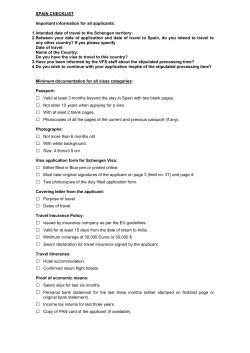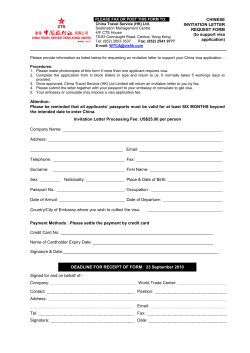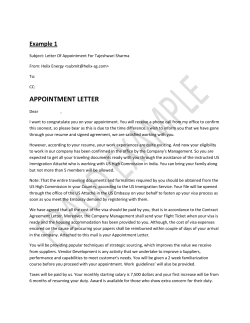
Information about travelling in Europe for non-EU citizens The Schengen Area
Information about travelling in Europe for non-EU citizens The Schengen Area The Schengen area is currently composed of 26 countries: Austria, Belgium, Czech Republic, Denmark, Estonia, Finland, France, Germany, Greece, Hungary, Iceland, Italy, Latvia, Liechtenstein, Lithuania, Luxembourg, Malta, Netherlands, Norway, Poland, Portugal, Slovakia, Slovenia, Spain, Sweden and Switzerland. In these countries the Schengen Visa Scheme is in force. This scheme allows people to travel across the countries within the Schengen area using only one visa. The UK and Ireland are not included in the Schengen area and therefore they are not part of the Schengen Visa Scheme. Thus, a non-EU citizen in the UK or Ireland wishing to visit one or more countries within the Schengen area will need a Schengen visa. The Schengen Visa Scheme There are three types of Schengen visa: Short stay or travel visa: allows a visit of up to three months in any six month period. This is the visa that most students will need to travel within the Schengen area as tourists or to attend conferences. Transit visa: enables travellers to pass through the territory of one or more Schengen member states on their way to another country outside the Schengen area. It can be issued for a maximum of five days. Airport transit visa: allows travellers to pass through the international transit area of an airport in the Schengen member state, but not to exit this area before flying on to their next destination. A circulation visa: is a short stay visa valid at least one year, is mainly issued for business visits that have an invitation letter from a Schengen country, to aircrew members, to people having a special interest in Schengen territory. You can also apply for a multiple entry visa, which allows you to enter the Schengen area several times. This means that you can return to the UK and re-enter the Schengen area at a later date. Please note that not all embassies issue multiple entry visas. Cardiff EDC Infosheet No.5 © Cardiff University, 2013 Where to apply for a Schengen visa If you will be visiting only one country in the Schengen area, apply to the embassy or consulate of that country. If you plan to visit two or more countries in the Schengen area, apply to the embassy or consulate of the country which represents your main destination, namely the country in which you plan to spend the most time during your trip. If you are visiting two or more countries in the Schengen area without having a main destination, apply to the embassy or the consulate of the country where you will first enter the Schengen area. How to apply for a Schengen visa Application procedures differ from country to country. Check the website of the relevant embassy or consulate, or contact them, to get information about the application process, eligibility criteria, visa fees and documentation required. What documents will you need to provide? Documents required may differ slightly from country to country, but they usually include: A completed application form. Original passport or travel document. Recent passport photographs. The exact number required varies between countries. Proof of the purpose of your visit, e.g. invitations from friends or conference organisers, or hotel reservations. Evidence of sufficient funds to complete your trip, e.g. bank statements or credit card statements. Evidence of student status. You will need to provide documentary evidence from your institution confirming that you are a full-time student. Medical insurance to cover the entire trip. Note that most Schengen states require your UK student visa to be valid for a certain period beyond the end of your trip. The length of time required will vary, but may be as long as six months. Visa fees It is advisable to check the current visa fee and which forms of payment are acceptable before submitting your application. Fees can usually be paid either in cash or by postal order; cheques and credit cards are not generally accepted. Note that the fee will not be refunded, even if your application is refused. How long will the application take? The process usually takes approximately three weeks, but depending on demand it could take up to eight weeks. It is therefore essential that you plan any trip to the Schengen area well in advance. Useful links Cardiff University Student Support Centre: Visas and Immigration Information and advice from experienced International Student Advisers, including ‘How to apply for a Schengen visa’. EUROPA: Summaries of EU Legislation: The Schengen Area and Cooperation Information on the history and development of the Schengen Area. Cardiff EDC Infosheet No.5 © Cardiff University, 2013 BBC News: Q&A: Schengen Agreement Questions and answers about the Schengen Agreement, including a map of the Schengen member states. Schengen Visa Services: Schengen Visa Application Information about the Schengen Visa Scheme, including a guide to the visa application in English, Spanish and Chinese. The Schengen Office: The Schengen Visa Explained The Schengen Office can assist with obtaining visas to popular destinations such as France, Germany and Poland. The site also provides links to the Embassy websites of the other Schengen member states. EUROPA: Travelling in Europe: Documents you will need Includes information for non-EU citizens. Further information European Documentation Centre Cardiff University PO Box 430 Cardiff CF24 0DE Tel: 029 2087 4262 Email: edc@cardiff.ac.uk This Infosheet is available online at http://www.cardiff.ac.uk/insrv/edc/findingout/index.html Revised by Alessandro Sitzia, March 2013 Cardiff EDC Infosheet No.5 © Cardiff University, 2013
© Copyright 2025


